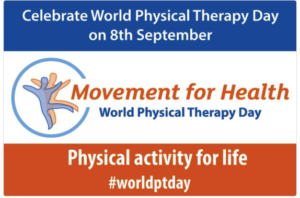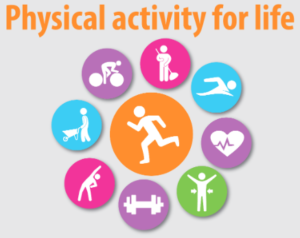The Physical Activity and Population Health BJSM Blog Series
By Sonia Cheng (@soniawmcheng)

Today, September 8 is none other than World Physiotherapy Day, and this year the World Confederation of Physical Therapy (WCPT) is celebrating the profession with the message ‘Physical activity for life’. This message builds on the World Health Organisation’s call for global efforts to reduce physical inactivity by 10% by 2025, and highlights the critical role played by physiotherapists in keeping people active.
Emma Stokes, President of the World Confederation for Physical Therapy, lends us her thoughts on how the physiotherapy profession can promote physical activity through the years and in the wider community.
Sonia Cheng (SC): Emma, we used to think that increasing physical activity was just a matter of “If you can move more, you will move more”. Then both clinical trials and clinical experience started to show us that you could not simply address pain, dyspnoea, or impairments in strength and mobility in isolation. Physical activity is a behaviour, and it is a complex behaviour. How do physiotherapists start to tackle this issue in everyday practice?
Emma Stokes (ES): Regardless of the reason why a person attends a physiotherapist, it represents an opportunity to have a conversation about physical activity. It’s important to be curious about how that person is meeting physical activity recommendations.
SC: Do you think it should become standard care for physiotherapists to set activity goals with their patients with respect to minutes of moderate-vigorous intensity physical activity per week, for example, or steps per day?
ES: It’s not necessarily about being prescriptive about practice, it’s more about raising awareness and exploring solutions to promote healthy levels of exercise and activity. This is a key responsibility for us as a profession as we respond to the challenges facing our communities in living active and healthy lives.
SC: What are some of the steps we can take as a profession to address physical inactivity on a population scale?
ES: World Physiotherapy Day 2017 is one component of the rich tapestry of solutions needed to promote physical activity across the lifespan and in all communities. As part of this year’s theme, the WCPT has a wonderful range of educational resources about the health benefits of physical activity. We also unpack the concept of metabolic equivalents (METs), and try to give examples of how different activities at different intensities can be combined over the course of a week to reach health-enhancing physical activity levels.
SC: How else can we get involved on our special day?
ES: Physiotherapists around the world can organise events in their workplaces and communities to promote “Physical activity for life”. We also come together on social media – last year, we had a rolling tweetchat across the twenty-four hours and three different time zones. See what celebrations and events have been organised in the past. The challenges of enhancing physical activity are enormous, and the solutions will require multifarious collaboration and coordination. World Physiotherapy Day is just one way the global physiotherapy community can come together to advocate for and celebrate our role in promoting health.
Well, you heard Dr Stokes. Get physical on September 8: discuss the physical activity guidelines with your patients and clients, put up posters in your workplace, check out the WCPT toolkit for some great resources about moving more and moving better.
Happy World Physiotherapy Day to all!

We invite you to share and support the Physical Activity and Population Health BJSM Blog Series. Join the conversation on ‘how change happens’ at #PAblogBJSM and #brightspotsBJSM.
If you have ideas for this series please contact: emmanuel.stamatakis@sydney.edu.au
Sonia Cheng graduated from The University of Sydney with a Bachelor of Applied Sciences (Physiotherapy) (Honours Class I) in 2014. Sonia is currently employed as a physiotherapist with Royal Prince Alfred Hospital and Westmead Hospital in Sydney.